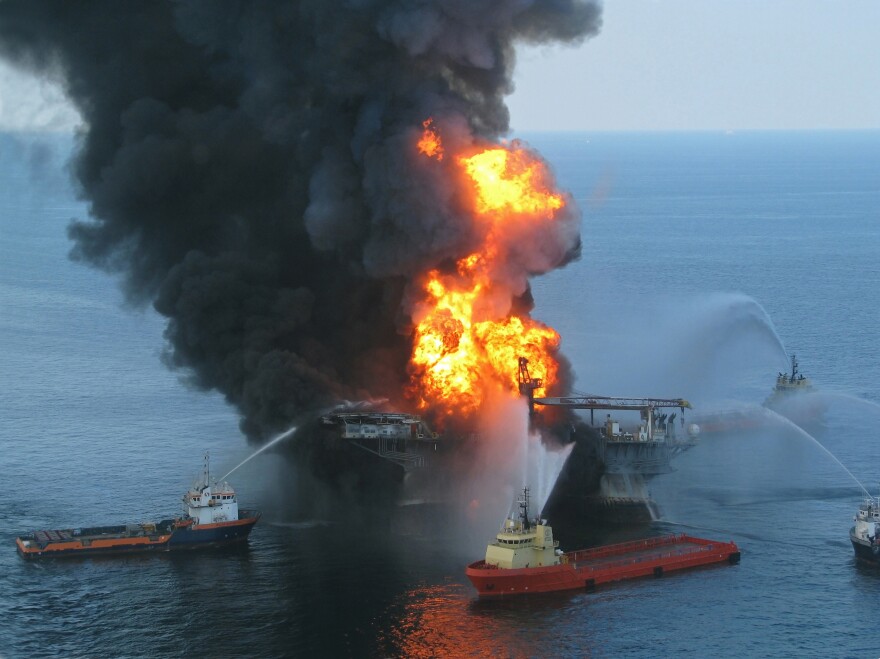Last week Florida Attorney General Pam Bondi announced a settlement between BP and the five Gulf States impacted by the Deep Water Horizon Spill. So what does that mean for Santa Rosa and Escambia Counties—two of the areas hit hardest by the spill?
The Ocean Conservancy has a flow chart showing how money from the BP spill is divvied up. Actually, they have five—one for each of the Gulf States involved. And flow chart might be a bit generous. It looks more like a handful of PowerPoint presentations all collided on the same page. It’s not their fault. It’s just really complicated. But Keith Wilkins has an analogy that helps.
“The whole aspect of the blow out can be compared to a person say under the influence of alcohol running a red light and hitting somebody,” Wilkins says.
Wilkins directs Escambia County’s natural resources department, and he helps out with the county’s RESTORE Advisory Committee.
“RESTORE is the ticket you receive for running the red light—it’s the fine,” Wilkins explains.
RESTORE Act funds come penalties paid by BP for violations of the Clean Water Act, and local officials administer a tranche of that money. But Wilkins says there’s a pot of money for Natural Resource Damages as well.
“That is to repair the vehicle that was hit,” he says, “the damages from the crash. So that was to repair our environment and our use of the environment from the actual oil spill itself.”
And BP is paying a substantial amount of money repair local economies, too—that’s actually the lion’s share of money coming to Florida. The far Northwest region of the panhandle was the area hit hardest by the spill, primarily Santa Rosa and Escambia.
In Santa Rosa, county commissioner Lane Lynchard is taking the lead on RESTORE act projects. He says his goal is to ensure the money has a lasting impact.
“I think if done right, RESTORE has the potential to have a generational impact on our region,” Lynchard says. “We have the opportunity to clean our water up. We have the opportunity to restore our bays, our estuaries, that otherwise we would not be able to do. There’s just, there’s not funding available for some of these projects, and they’re cost prohibitive for local governments to do.”
One county west, Pensacola beach is filling up for this weekend’s Blue Angels air show. It’s an annual draw that fills the shoreline with spectators, and brings customers to places like Paradise bar and grill. There are big fans running, hardly any seats at the bar and the tables are filling up. But a few years ago, in the wake of the spill, tourism here took a major hit. Fred Simmons owns the restaurant and handful of other businesses under the same name.
He says the spill cost him millions.
“It was a nightmare,” Simmons says. “I mean nobody wanted to come here, it wound up being one of the worst years I’ve had in years, and it was going to be one of the best year’s I’d ever had. But since then we’ve recovered.”
Most seem to view last week’s settlement pretty favorably, and they’re excited for the local projects RESTORE will support. But there’s some concern about how the money will be allocated. Florida’s going to receive $3.25 billion under the agreement, but again, it’s split into three separate buckets. The largest chunk is $2 billion for economic claims. The remainder is split between natural resource damages—that’s $680 million—and then the RESTORE act—which is $572 million.
But RESTORE is also subdivided to allow for numerous kinds of projects, and that has some environmental groups worried. Julie Wraithmell from Audubon Florida says, with the majority of the state’s money earmarked for economic claims already, the remainder should be dedicated to environmental work.
“You know we really think with the $2 billion award for economic damages, it’s only reasonable that the natural resource damage assessment dollars and RESTORE dollars be focused entirely on environmental restoration,” Wraithmell says. “Because after all in Florida, our ecology is our economy.”
And Simmons says environmental investment is good for business too.
“Yeah that is, that’s got to be a top priority, and anything—again I don’t know what they have in mind, but I would be all for anything environmentally that was done to help the environment and help us come back even stronger,” Simmons says.
Another important piece of the settlement is its timeline. Under the agreement BP is set to make payments for more than a decade—to some extent limiting the size and scope of projects counties can undertake. And although there seems to be consensus about the need to maintain some kind of environmental focus for RESTORE, there was also broad consensus for the principles behind Amendment One. Whether officials are getting RESTORE right is going to be a long and ongoing conversation.


